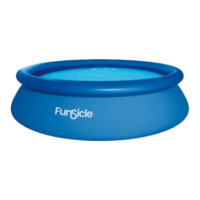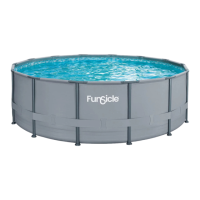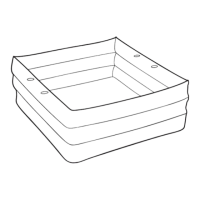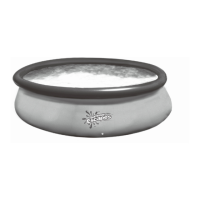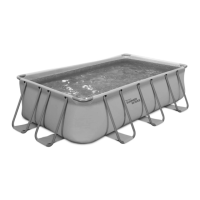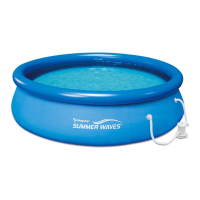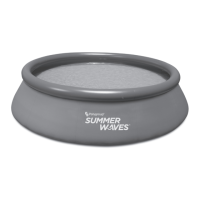10
FILTRATION SYSTEMS
Any equipment connected to the circulation systems shall be positioned so as to prevent their being used
as a means of access to the pool by young children. (See the latest published edition of ANSI/APSP-8 Model
Barrier Code for Residential Swimming Pools, Spas, and Hot Tubs.)
BARRIER
Barrier is necessary to provide protection against potential drowning and near drowning, and barriers are
not a substitute for the constant supervision of children. (See latest published edition of ANSI/APSP-8 Model
Barrier Code for Residential Swimming Pools, Spas, and Hot Tubs.)
RISK OF DROWNING, ENTRAPMENT, AND DIVING ACCIDENTS
Publications are available that describe the risk of drowning, entrapment, and diving accidents. Available
publications related to pool safety include the Association of Pool and Spa Professionals’ (APSP) booklets
entitled: The Sensible Way to Enjoy Your Above-ground/On-ground Swimming Pool, Children Aren’t
Waterproof, Pool and Spa Emergency Procedures for Infants and Children, Layers of Protection, and the latest
published edition of ANSI/APSP-8 Model Barrier Code for Residential Swimming Pools, Spas, and Hot Tubs.
Safety Guidelines
IMPORTANT SAFETY INSTRUCTIONS
When installing and using this product, basic safety precautions should always be followed, including
the following:
READ AND FOLLOW ALL INSTRUCTIONS
Keep this User Guide for future reference. Failure to follow these warnings and
instructions can result in serious injury or death to users, especially children.
• Pool presents a drowning hazard even during filling and draining of the pool. Maintain constant
supervision of children and do not remove any safety barriers until the pool is completely empty
and stowed away.
• Children, especially children younger than five years, are at high risk of drowning. Drowning occurs
silently and quickly and can occur in as little as 2 in (5 cm) of water.
• Keep children in your direct sight, stay close, and actively supervise them when they are in or near
this pool and when you are filling and emptying this pool.
• When searching for a missing child, check the pool first, even if child is thought to be in the house.
• Do not leave toys inside pool when finished using, since toys and similar items might attract a child
to the pool. Position furniture (for example, tables, chairs) away from pool, so that children cannot
climb on it to gain access to the pool. After using pool, remove water to a level of ½ in (1 cm) or less.
• Locate pumps and filters in such a way that children cannot climb on them and gain access to the
pool.
SWIMMING POOL BARRIERS
• Swimming pool barriers, which restrict access to the pool by small children, may be required by
law. A barrier is necessary to provide protection against potential drowning and near drowning.
Barriers are not a substitute for constant supervision of children.
• Keep unsupervised children from accessing the pool by installing fencing or other approved barrier
around all sides of pool. State or local laws or codes may require fencing or other approved
barriers. Check state or local laws and codes before setting up pool.
• See latest published edition of CPSC Pub. No. 362 found at poolsafely.gov.
SWIMMING POOL EQUIPMENT
• The use of artificial pool lighting is at the discretion of the pool owner. Lighting, when installed,
should be in accordance with Article 680 of the National Electrical Code (NEC®) or its latest
approved edition and in consultation with a licensed electrical professional.
• Keep all electrical lines, radios, speakers, and other electrical appliances away from the pool.
• Do not place pool near or under overhead electrical lines.
• For swimming pools, fountains, and similar installations, and any state or local code, all electrical
components installed in and/or adjacent to an above-ground/on-ground residential swimming
pool shall be installed in accordance with and shall comply with the requirements of the latest
published edition of NFPA 70, National Electrical Code (NEC®) Article 680. For more information,
visit nfpa.org.
SWIMMING POOL AWARENESS
• ADULT ASSEMBLY REQUIRED: This pool may contain potentially hazardous sharp edges, sharp
points, or small parts.
• Do not install the pool on a slope or inclined surfaces, on soft or loose soil conditions (such as
sand or mud), or on an elevated surface such as a deck, platform or balcony. It may collapse
under the weight of the filled pool.
• TO AVOID DANGER OF SUFFOCATION: Keep the plastic bag used in this product away from babies
and children; do not use the bag in cribs, beds, carriages, or playpens. The plastic bag could block
the nose and mouth and prevent breathing. The plastic bag is not a toy.
• If a drain or suction outlet cover is missing or broken, do not use the pool. Suction can cause body
part entrapment, hair and jewelry entanglement, or drowning. Repair or replace the drain or
suction outlet cover before using the pool again
• When using the pool at night, artificial lighting should be used to illuminate all safety signs, ladders,
steps, deck surfaces, and pathways.
• The floor of the pool shall be visible at all times from the outside perimeter of the pool.
• Keep your pool clean and clear. The deepest part of the pool must be visible at all times from
outside of the pool.
• Call for emergency if needed.
• Basic lifesaving equipment, including one of the following, should be on hand at all times:
- A light, strong, rigid pole (shepherd's crook) not less than 12’ [3.66 m] long.
- A ¼” [6.35 mm] diameter rope as long as one and one half (1 ½) times the maximum width of
the pool or 50’ [15.24 m], whichever is less, which has been firmly attached to a Coast
Guard-approved ring buoy having an outside diameter of approximately 15” [38.1 cm],
or similarly approved flotation device.
• The pool is subject to wear and deterioration. If not maintained properly, certain types of
excessive or accelerated deterioration can lead to a failure of the pool structure that might
release large quantities of water that could cause bodily harm and property damage.
• Never allow fooling around, diving, or jumping into or around the pool. This could lead to serious
injury, paralysis or death. Do not allow anyone to swim alone without supervision.
• Pool shall be located at a minimum distance of 6 ft (1.83 m) from any receptacle, and all 125-volt
15- and 20-ampere receptacles located within 20 ft (6.0 m) of the pool shall be protected by a
ground fault circuit interrupter (GFCI), where distances are by measuring the shortest path the
supply cord of an appliance connected to the receptacle would follow, without piercing a floor,
wall, ceiling, doorway with hinged or sliding door, window opening, or other effective permanent
barrier, to the inside wall of the pool.
CIRCULATION SYSTEMS
• Follow written instructions regarding positioning of all equipment connected to the circulation
systems and operating the components.
• Circulation equipment should be installed per manufacturer’s instructions to provide proper
mounting and support, to prevent damage from misalignment, settlement, and vibration, and to
minimise the potential for the accumulation of debris and moisture. Please refer to the pump's
user guide.
• A replacement pump should never exceed the maximum flow rate marked on the suction fitting.
LADDER
• The ladder should be located on a solid base and is to be installed per the manufacturer’s
instructions.
• One person on the ladder at a time.
• This ladder is designed and manufactured for a specific pool wall height and/or deck of the pool.
• When entering/exiting the pool, face the ladder at all times.
• To prevent entrapment or drowning do not swim through, behind, or around the ladder.
• Remove and secure the ladder when pool is not occupied.
POOL COVER
Pool covers used for safety barriers shall comply with the latest published edition of ASTM F-1346,
Standard performance specifications for safety covers and labeling requirements for all covers
for swimming pools, spas, and hot tubs.
CHEMICALS
For safety's sake, ensure the deepest part of the pool is always visible. The user must properly
maintain pool water clarity at all times. Check the pH and chlorine levels periodically, and make
sure they are within the recommended limits. Additional water treatment chemicals might be
needed from time to time. Have the water sample tested by a local pool supply store to
determine if additional chemicals are needed. Turn on the pump for the recommended hours
daily. If you are unsure of the time frames please refer to funsicle.com/support for the
recommended Pump Operation Hours based on pool types and sizes. Clean and replace filter
cartridge frequently. Replace only with genuine Funsicle Brand filter cartridges. Refer to the Filter
Pump User Guide for additional water care information.
RISK OF ENTRAPMENT
• Entrapment Avoidance: There shall be no protrusions or obstruction in the swimming area, which
may cause entrapment or entanglement of the user. If a suction outlet cover is missing or broken,
do not use the pool. Suction can cause body part entrapment, hair and jewelry entanglement,
evisceration, or drowning. Repair or replace the suction outlet cover before allowing the pool to
be used.
• Never play or swim near drains or suction fittings. Your body or hair may be trapped, causing
permanent injury or drowning.
RISK OF DROWNING
• Keep unsupervised children from accessing the pool by installing fencing or other approved
barriers around all sides of pool. State or local laws or codes may require fencing or other
approved barriers. Check state or local laws and codes before setting up the pool.
• Remove pool ladders after leaving the pool.
• Toys, chairs, tables, or similar objects that a young child could climb should be at least four feet
(4’) [121.92 cm] from the pool. The pump filter system should be positioned so as to prevent it from
being used as a means of access to the pool by young children.
DIVING RISK
• Above-ground/on-ground residential swimming pools are for swimming and wading only. No
diving boards, slides, or other equipment are to be added to an above-ground/on-ground pool.
• Do not dive into this pool. Diving into shallow water can result in a broken neck, paralysis, or death.
RISK OF ELECTROCUTION
• Keep all electrical lines, radios, speakers, and other electrical appliances away from pool.
• Do not place the pool near or under overhead electrical lines.
FIRST AID
• Keep a working phone and a list of emergency numbers near the pool.
• Become certified in cardiopulmonary resuscitation (CPR). In the event of an emergency,
immediate use of CPR can make a lifesaving difference.
SPECIAL WARNING
• Local building codes may require obtaining a building or electrical permit. The installer shall
follow regulations on setback, barriers, devices, and other conditions.
• Safety signs shall comply with requirements of ANSI-Z535 and use signal wording.
•
DO NOT attempt to assemble this pool in adverse weather conditions, windy conditions, or when
the temperature is below 60°F.
• This is a storable pool, which should be disassembled and stored when temperatures are
expected to fall below 32°F.
• Ensure that all pools and their related components that are installed in an indoor environment
should comply with the ventilation requirements of ANSI/ASHRAE 62 or the latest published edition
of Ventilation for acceptable indoor air quality, Table 2, Article 2.1.
• The placement of the pool and portable pools shall be set up so that they comply with local
safety and building codes.
EXTRA SAFETY WARNING
• When you touch the filter, pump, or electrical parts, be sure the ground under your feet is “Bone
Dry.”
• Connect power cords to a 3-wire grounding-type outlet only.
• Keep all breakable objects out of the pool area.
• Alcohol consumption and pool activities do not mix. Never allow anyone to swim, dive, or slide
while under the influence of alcohol or drugs.
• Severe electrical shock could result if you install your filter pump on a deck. The pump or filter
could fall into the water, causing severe shock or electrocution.
• Do not allow roughhousing and fooling around.
• Do not engage in extended breath holding activities underwater; you may black out and drown.
• Install pool ladder(s) or a staircase for entry and exit from the pool.
• Check regularly for signs of wear on the liner or any loose parts that could make pool unsafe.
• Instruct pool users about the proper use of all pool ladder(s) and staircases.
• Check all nuts and bolts regularly to ensure that the ladder stays sturdy.
• Contact pool site dealer or manufacturer for additional safety signs if deemed necessary.
• For pool service, choose a certified pool professional. For more safety information, see APSP.org
CONSUMER AWARENESS BOOKLETS AND INFORMATION SOURCE
Contact: U.S. Consumer Product Safety Commission at cpsc.gov/Safety-Education/Pools-and-Spas,
Pub. #362 “Safety Barrier Guidelines for Home Pools.”
• The Sensible Way to Enjoy Your Above-ground/On-ground Swimming Pool.
• Children Aren’t Waterproof.
• Layers of Protection.
• Pool and Spa Emergency Procedures for Infants and Children.
• Be Safety Aware Copies of the above brochures are available free from the APSP. Go to: APSP.org
If you are going to use a pool cover, solar cover, or solar blanket, please read this information.
POOL COVER WARNING / SOLAR COVER WARNING / SOLAR BLANKET WARNING
IMPORTANT: Do not use a pool cover, solar cover, or solar blanket on this pool if it does not have this type of
warning label on the cover.
DANGER: Competent supervision and knowledge of the safety requirements are the only ways to prevent
drowning or permanent injury in the use of this product! Never leave young children unattended.
Pool Cover Safety
Pool Safety Sign
NO DIVING OR JUMPING
SHALLOW WATER
DIVING MAY RESULT IN PERMANENT INJURY OR DEATH
• Be Safe.
•
Children must be accompanied by an adult.
•
Don’t swim when using alcohol or drugs.
•
Be familiar with the pool before swimming.
•
No running, jumping, or horseplay in or around pool.
•
No glass in pool area.
TO AVOID SERIOUS INJURY ALL POOL USERS MUST KNOW AND FOLLOW THESE SAFETY RULES.
WARNING
Post This Warning Near Your Pool.
AVOID DROWNING RISK
This cover (if included) meets requirements described in specification ASTM F-1346.
Type OC cover classification.
WARNING:
INSTALLER RESPONSIBILITIES
All of these components shall be positioned so as to prevent their being used as a means of access to the
pool by young children. All safety signs shall be affixed above the water line according to manufacturer's
instructions. (See the latest published edition of ANSI/APSP-8 Model Barrier Code for Residential Swimming
Pools, Spas, and Hot Tubs.)
SAFETY EDUCATION PROGRAMS AND MATERIALS
Educational programs and materials (i.e. seminars, workshops, brochures, videos, instructional guides) are
available from the APSP, other aquatic safety groups, and by private firms. As a means of communicating
useful safety information to pool owners/operators and users, industry members are permitted to provide
such information to owners/operators and to request or require owners/operators to sign a statement that
they have received, read, and will follow the guidelines.
Other sources of safety information:
• cdc.gov
• cpsc.gov
• drowningpreventionalliance.com
• nspf.org
• safekids.org
NSF International
P.O. Box 130140
789 N. Dixboro Road
Ann Arbor MI 481105
Contact: 800-673-6275 or 734-769-8010
nsf.org
ANSI American National Standards Institute
25 West 43rd Street, New York NY 10036
Contact: 212-642-4900
ansi.org
ASTM International (formerly American
Society of Testing & Materials)
100 Barr Harbor Drive, P.O. Box C700 West
Conshohocken, PA 19428-2959
Contact: 877-909-2786 (USA & Canada)
or 610-832-9585 (International)
astm.org
APSP Association of Pool & Spa Professionals
(Formerly National Spa and Pool Institute)
2111 Eisenhower Avenue, Ste. 500
Alexandria VA 22314-4679
Contact: 703-838-0083
apsp.org
NEC National Electrical Code (see NFPA)
NFPA National Fire Protection Association
1 Batterymarch Park, Quincy MA 02169-7471
Contact: 800-344-3555 (U.S. & Canada) or
617-770-3000 (International)
nfpa.org
NSPI National Spa and Pool Institute (see APSP)
UL Underwriters Laboratories
333 Pfingsten Road, Northbrook IL 60062-2096
Contact: 877-854-3577 or 847-272-8800
ul.com
ASME American Society of Mechanical Engineers
Two Park Avenue, New York NY 10016-5990
Contact: 800-843-2763 (USA & Canada) or
973-882-1170 (Outside N. America)
asme.org
Location Requirements
• Set up the pool only on level, stable, and compact soil.
• Do not set up the pool on sand surface.
• Excessive sand inside the pool will damage the pool liner and
filtration system.
Failure to follow these instructions will void the warranty.
NOTICE: Customers who purchase pools may be required by local or state law to incur additional expenses
when installing a pool, in order to comply with state or local laws regarding fencing and other safety
requirements. Customers should contact their local building code enforcement office for further details.
Polygroup is not responsible for any additional expenses that you may incur.
SAFETY CARE FOR CHILDREN
• Assign an adult to be responsible for watching children in the pool. Give this person a “water
watcher” tag and ask that they wear it the entire time they are in charge of supervising children in
the pool. If they need to leave for any reason, ask this person to pass the “water watcher” tag and
the supervision responsibility to another adult. For replacement of the water watcher tag, visit
funsicle.com.
Warnings
DO NOT SIT ON
OR LAY OVER
POOL WALL
Read and follow all safety information and assembly instructions in the User Guide.
WARNING:
• Closely watch children who are in or
near this pool.
• Children under 5 are at highest risk
for drowning.
•
Do not leave child unattended while in use.
• Use only under competent supervision.
• Empty the pool or prevent access when
not in use.
•
Stay away from drains & suction fittings,
your hair, body, & jewelry can get
sucked into drain. You could be held
under water & drown.
• Do not use pool if drain or suction outlet
cover is missing or broken.
Install a pool fence around the pool to prevent children from gaining unauthorized access and drowning.
State or local codes may require fencing and other safety measures (not included), such as a pool alarm.
Consult local building code officials for requirements.
PREVENT DROWNING! AVOID ENTRAPMENT!
You can break
your neck and
be paralyzed.
NO DIVING!
SAVE THESE INSTRUCTIONS
• Pool cover (if included) is not a safety cover.
•
Keep children away from cover. Children or objects cannot be seen under cover.
•
Stay off cover – Will not support weight.
•
Remove standing water. Child can drown on top of cover.
•
Lay cover on top of water surface.
•
Use drawstring to secure pool cover to pool (if applicable).
•
Non-secured or improperly secured covers are a hazard.
•
Install pool cover with labels facing up.
•
Remove cover(s) completely before entry of bathers – Entrapment possible.
•
Failure to follow all instructions may result in injury or drowning.
NEVER LEAVE YOUNG CHILDREN UNATTENDED
IN OR AROUND POOL COVER.
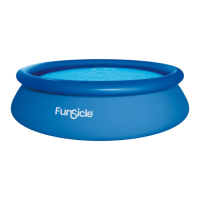
